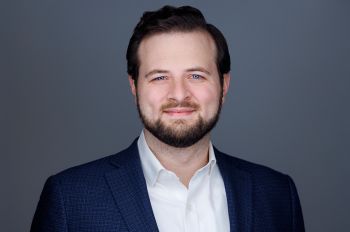Chicago-Kent Professor Researches the Constitutionality of Restricting Travel Under Quarantine

Since the COVID-19 pandemic hit, there have been numerous instances in the United States where state governments have used quarantines to curb travel.
While most challenges to quarantines have failed, recent research by Chicago-Kent College of Law Assistant Professor Noah Smith-Drelich explores how an underutilized tenet of the Constitution—the right to travel—could provide a more fruitful basis for scrutinizing quarantine regulations.
“These rights are very well established by the Supreme Court, but not very well known,” Smith-Drelich says.
His paper “The Constitutional Right to Travel Under Quarantine” has been accepted for publication in the fall 2021 edition of the Southern California Law Review.
Smith-Drelich stresses that he is not arguing that such quarantines aren’t important, or that they are unconstitutional, simply that they should be subject to a more stringent form of judicial review. His paper lists historical instances when quarantines led to overreach, particularly against minorities and the disenfranchised.
“Quarantines are a crucial public health tool. Emergencies, though, are when we should be most attentive to our rights,” Smith-Drelich says.
A cornerstone of case law relating to public health mandates is Jacobson v. Massachusetts, a 1905 U.S. Supreme Court case that explored whether municipalities had the power to mandate a smallpox vaccination. The plaintiff, a Cambridge, Massachusetts, minister, refused a shot and was fined $5; he argued that the Constitution gave him the liberty to refuse a vaccination that he believed was dangerous. The court disagreed.
Since then, the Jacobson case has been cited to set a standard highly deferential to government entities. According to the dominant view of Jacobson, public health measures must either include “beyond all question, a plain, palpable invasion of rights” or have “no real or substantial relation” to the government’s public health goals in order to be deemed unconstitutional.
“Needless to say, this does not present a terribly high bar for policymakers to overcome,” Smith-Drelich writes.
But governments have at times taken this too far, infusing quarantines with race, gender, or class-based discrimination.
In 1900 the Hawaiian territorial government prohibited Chinese and Japanese residents, but not white ones, from leaving the island of O’ahu after a small number of bubonic plague cases appeared. And in Jew Ho v. Williamson, Chinese-American residents of San Francisco were quarantined, though white residents were not, ostensibly to control a bubonic plague outbreak.
Though the quarantine in Jew Ho was successfully challenged, Smith-Drelich writes, “Time after time, judges have upheld, under cover of extreme deference, the state’s authority to violate rights and liberties during times of a public health emergency.”
In his research, Smith-Drelich explores case law centering on an aspect of the Constitution that he believes could present a more meaningful lens for evaluating quarantines: the right to travel.
“The Constitution guarantees, at the very least, a right to free movement, to travel between the states, and to relocate from one state to another,” he writes, adding, “The constitutional right to interstate travel alone is protected by at least three different provisions of the U.S. Constitution.” One justification noted in case law: citizens have the right to travel to governmental seats of power to bring claims or protest.
That’s not to say public health emergencies still can’t overcome such protections, Smith-Drelich writes. In general, courts have held that brief or narrow restrictions on movement don’t implicate these rights, and even stringent regulations will survive when they are carefully constructed around the public health needs.
In Saenz v. Roe, Smith-Drelich notes, the Supreme Court said the “right of ‘free ingress and regress to and from’ neighboring states” is deeply rooted in the history and tradition of the U.S. In Kent v. Dulles, the court wrote that the right to travel “across frontiers in either direction, and inside frontiers as well, was a part of our heritage,” dating to the Magna Carta.
In Papachristou v. City of Jacksonville, the court tossed out a Jacksonville, Florida, vagrancy ordinance that criminalized “wandering or strolling around from place to place without any lawful purpose or object.”
Wandering and strolling were “historically part of the amenities of life as we have known them,” the court wrote.
Perhaps more importantly, Smith-Drelich notes, the Constitution’s privileges and immunities clause makes it unconstitutional to treat nonresidents of a state any differently when traveling in or through that state.
There have been multiple recent examples of COVID-19-related quarantines that may fall afoul of the privileges and immunities clause, Smith-Drelich believes.
The Florida Keys, for instance, shut down access to any outsiders at one point of the pandemic. Rhode Island imposed self-quarantine requirements on nonresidents—even those from states with few detected COVID-19 cases. And Alaska mandated COVID-19 testing for people traveling into the state. Such testing was free for residents, but cost nonresidents $250.
“It’s encouraging to see policymakers think creatively about how to control the spread of COVID-19,” Smith-Drelich says, “but regulations must be tailored to the public health demands at hand.”
In the end, Smith-Drelich concludes, the system works best when suits challenging quarantines don’t try for injunctions (as most suits unsuccessfully have) to stop the quarantines, but rather ask for “ex-post” relief, or monetary damages after the fact.
“The result will be more instances in which victims of state overreach are made whole,” Smith-Drelich says, “and also more quarantines left to protect the public health.”
Photo: Assistant Professor of Law Noah Smith-Drelich discusses the constitutional right to travel as part of a 'know-your-rights' training for the Standing Rock-led movement against the Dakota Access Pipeline in 2016 [Sydwell Media, used with permission].




